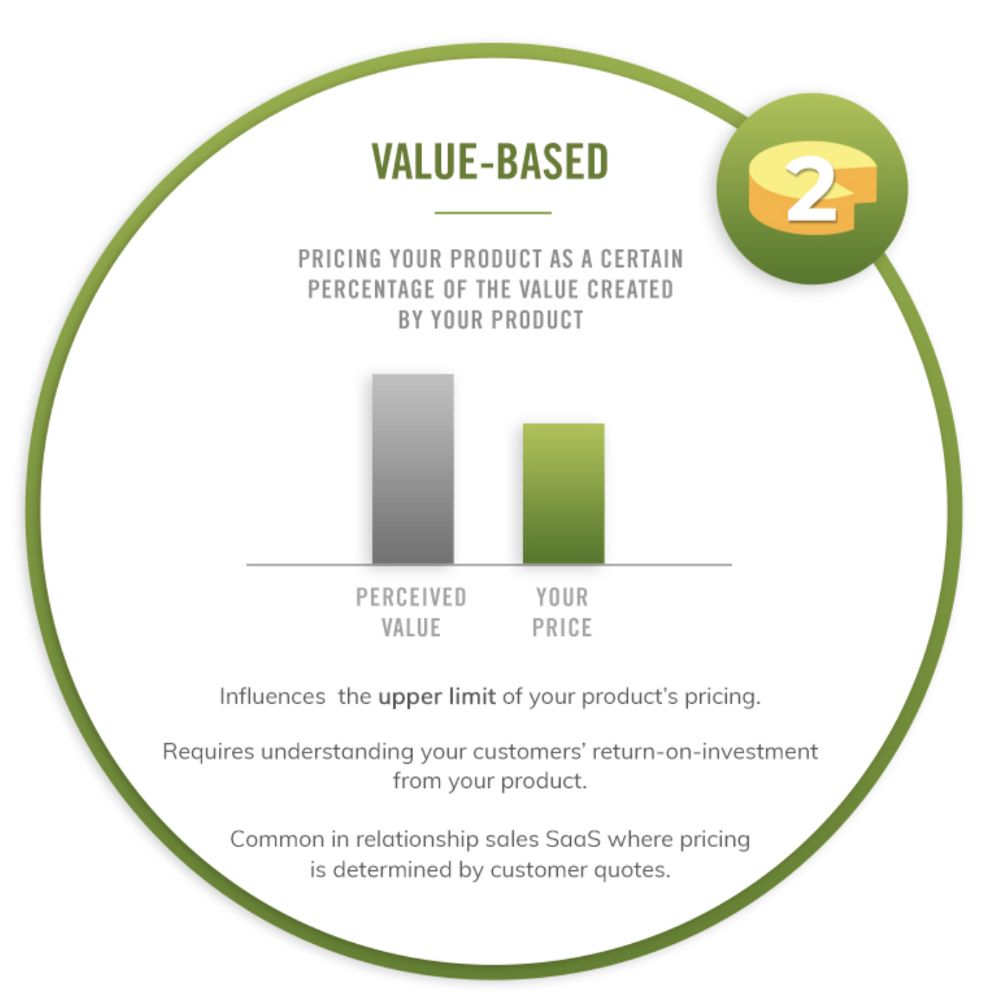Put your growth on autopilot
GrowSurf is modern referral program software that helps product and marketing teams launch an in-product customer referral program in days, not weeks. Start your free trial today.
Your customer should be the most important factor in your business. Whether it's your inbound marketing or your pricing strategy, there are better chances of success if you focus these elements around your customer. SaaS products are unique and that gives you the opportunity to have a unique pricing strategy as well, which can prove to be game-changing.
Using your competitors’ and your costs as a baseline for your price, is a disservice to the value your products create. Identify the actual worth of your solutions and you can use your pricing page to motivate customers, stand apart from competition, and boost revenue.
A 1% improvement in prices results in an 11.1% increase in operating profit. That is a massive shift and proof that pricing can make or break your business. Your price can help define you and your brand. As a SaaS company, value-based pricing can help you focus on your ideal customer and let them dictate your pricing.

Image Source: Medium
Value-based pricing is a dynamic pricing strategy that is dependent on the perceived value of a product or service. What this means is that your product’s price won't be calculated based on historical fees, your ideal profit margins, your production costs, or overhead. You’ll establish a price based on how much you think potential customers are willing to pay for the value your product offers.
For this to work, you’ll have to zero in on specific customer segments—the customers whose pain points your products or services target. This is the customer who finds the most value in your SaaS solutions. You can use value-based pricing to give a significant boost to your revenue without an impact on volume.
Traditional pricing strategies are based on everything but the customer. You achieve minimal profitability and ignore how much the customer is willing to pay. SaaS products are distinctive in their offering, which means that they're better positioned to implement the value pricing model. Only the customer can identify what your SaaS solution is worth to them. Value-based pricing means listening to your customer and making a profit maximizing decision.
To put this in perspective, let’s assume we have a SaaS company that sells business communication solutions like enterprise phones, VoIP, fax over internet, contact center services and the like. The customer could use free VoIP services for internal communications, but if they want to implement a paid one, it's because of the numerous features and benefits offered by the company.
The price the customer is willing to pay is based on the following:
You would think the existing market price and your competitor’s price would influence what the customer thinks your SaaS solution is worth.
Newsflash: it doesn't.
Customers couldn’t care less about your costs or those of your competitor’s; their only concern is the benefit they can get at a particular price.

For SaaS companies, value-based pricing is the best option. A simple pricing method like cost-plus pricing, wouldn’t be viable because software doesn't function in the same way as other retail products.
Once you create software, the major brunt of your work is done. How much of your costs are the maintenance and delivery of the software? Minimal. Taking your software development costs as baseline doesn’t make sense, you’re not developing a unique solution for every customer. You can choose to make a profit in two ways:
This all comes down to defining your target market and deciding how you would like to position your product. Ask yourself the following questions before you decide to launch a value-based pricing strategy for your SaaS company:
Ideally, everyone would like to make a lot of money from as few customers as possible.
Because to have more customers, your marketing, advertising, and sales costs would also increase, and exponentially so. Customer acquisition is expensive. If you can enjoy the same profits from fewer customers, why wouldn’t you?
Enable growth by identifying a niche market for your products and services. Serve them with a dynamic value-based pricing model that supports customer retention as well.
Pricing is not just the cost of your product. it's part of your product identity. When you develop a customer-focused pricing strategy, there are tangible and intangible benefits apart from a better bottom line. It can be a rewarding approach with the following advantages.
Customer needs and demands are forever changing. Especially in technology, it's a fickle world.
When your pricing is dependent on what your customer wants, your product will also evolve.
This will make your product development tied with your pricing methodology and vice versa, working together for continuous improvement. You can streamline software implementation and introduce supplementary features that will improve your offering.
Let’s say you’re a domain name provider, for example. You started off with.com and.org products. Researching the market has informed you that people in tech want to buy io domain names as well. You decide to offer that to improve your product range and grab a better market share while, of course, delivering quality domain names to the market.
Value-based pricing is favorable to the seller because you can sell it at a much higher markup, providing the service is worthy. Consumers might pay more for the privilege or prestige of owning a product but the exciting part is that you can manipulate perceived value.
The best way is to create a product that customers are willing to pay anything for. Another way is to run branding and awareness campaigns that position your product as one that deserves a higher price point, thereby increasing your perceived value.
Creating value-based pricing requires intensive research about your customers, the market, and the competition. Having so much data on hand gives you broader knowledge about your industry that can be beneficial for your lead generation strategy.
It also helps you identify where you stand amongst the competition.
It can also tell you if your competitors have cost-based or value-based pricing. This can help you decide if you want to bag a bigger market share based at a lower price point or a better product quality.
Communicating with customers to figure out what your products’ perceived value is improves more than just your pricing. As you request customers for feedback through surveys and interviews, you will find that your customers appreciate the attention. You can use customer feedback to improve your products and services as well.
You will have yourself a 5 star SaaS customer service by communicating often with your customers to learn about their “willingness to pay”. While you're closely listening to their concerns, they will see you as involved and empathetic. Close communication with customers to identify their pain points will strengthen your relations with them and improve retention.

Developing a pricing model requires empirical marketing research and experimentation, to figure out who your customers are and what they want. Follow the steps below to build an effective and competitive pricing strategy.
You need to identify your target market, especially if you’ve decided you want to focus on a niche market. The best way to do so would be to analyze your current customers and decide what demographic they fall into and build a customer persona based on them.
Do remember, your customer persona is not just the business you're dealing with but also the key decision makers. At the end of the day, even B2B businesses are building relationships with other people.
Your target market can be selected as per the following:
Customer analysis is the key to value-based pricing.
Your price is solely dependent on what your customer is willing to pay. You cannot do guesswork here. You need solid data to back up your price point. There are multiple ways to ask customers what they're willing to pay. You could use feedback forms, surveys, and cold calling.
Before you start researching your entire target audience, start with your current customers.
Existing customers are the easiest to contact and they're familiar with your product and also its value. They can help you learn how much they would be willing to spend on your products. This won't only help you improve the product based on customer feedback; it will also inform you how the product is affecting their lives.

Customer data is essential and relatively easy to collect, but it's a biased sample. Those customers have already bought your product. You need to research the entire addressable market to devise a price that can help acquire new customers.
The ways to do this would be talking to prospects and leads generated from your website or other marketing efforts. Visitor segmentation on your websites is easy, and can help identify which visitors are more likely to end up as customers. You can target your marketing efforts to convert them but also contact them to know what their “willingness to pay” is.
Ask anyone you would attempt to sell your product to, what they think of your offering and what price they would be willing to pay for it.
Research the competition on SaaS marketplaces and figure out how they set their prices. Is it similar to you? Do they have a bigger share? Do you have to compete on brand quality and brand loyalty? Find out how your target market values their product and you’ll get some insight for yourself.
Try not to copy your competition but instead aim for market diversity and focus on how you can add more value to your customers’ lives as compared to your competitors. To be meaningful to your target customer, you have to be able to differentiate your SaaS product.
Your SaaS product prices should be relative to the value you offer the customer. Your customer is concerned about just that value and so should you be. To stand out in a value-driven market that demands dynamic pricing, your brand needs to be flexible in terms of what they want to sell and to who. Don’t be afraid to service a narrow vertical; the riches are in the niches.
Determine your product value through meticulous research. This helps you understand what motivates your customers and helps you make informed decisions about your price and products. SaaS companies can supercharge their growth by leveraging a value-based pricing strategy that gives deep insights into what the customer wants.
Market and advertise your product to build brand value. This will help with customer acquisition and customer loyalty. If you’re in the SaaS space, know that value-based pricing is an incredibly effective method to combat churn while maximizing profits.
Value-based pricing requires dedication, it's a process of continuous improvement that helps you create long-term value, delight customers, increase agility, and build more competitive products.
Sign up for a free trial of GrowSurf to lower your customer acquisition costs, increase customer loyalty, and save gobs of time.


GrowSurf is modern referral program software that helps product and marketing teams launch an in-product customer referral program in days, not weeks. Start your free trial today.
Learn everything you need about B2C SaaS referral marketing in our complete guide to designing, launching and optimizing your customer referral program.
Demand generation is a powerful tool for customer acquisition. Here's how it can help you bring in new qualified leads as you battle for brand awareness.
SaaS referral programs are one of the most cost-efficient ways for startups to gain new signups and paying customers. Here's 5 reasons why and examples to study
SaaS pricing can be one of the most challenging parts of operating a software company. Here is a breakdown of how to make a successful SaaS pricing strategy.
Looking for referral program inspiration? In this post, we've compiled 41 referral program examples, with screenshots of their websites, emails, and user flows.